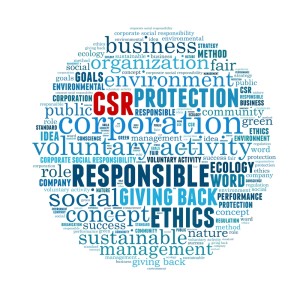Corporate Social Responsibility (CSR) was the trend a few years back to only suddenly be taken out of the priority lists of companies. Which they should not have done, practice shows.
CSR’s Rise and Fall
The reason for the rise of CSR was at first not ethical at all – it was an attempt by American tobacco companies to avoid legislation. However, the practice was quickly adopted by other industries and rebranded as companies noticed that there is demand for CSR which they could capitalize on.
Especially the CSR pioneers benefited greatly from relatively small CSR moves as supporting the local sports team or a new medical program. While there is no doubt that none of this was done out of pure philanthropy, companies consciously engaging with local communities or global issues were seen as the better ones.
 Thus, not so long after the first companies started their CSR programs many others followed. It is there where the problems started: not doing it right, overdoing it or trying too hard to get the efforts popularized turned CSR into a less profitable strategy as it generally lost consumer trust. Consumers could see that it is all just a sales trick and stopped giving companies the credit for trying.
Thus, not so long after the first companies started their CSR programs many others followed. It is there where the problems started: not doing it right, overdoing it or trying too hard to get the efforts popularized turned CSR into a less profitable strategy as it generally lost consumer trust. Consumers could see that it is all just a sales trick and stopped giving companies the credit for trying.
While in the beginning of the 21st century the majority of consumers in the developed world stated they would prefer a product based on the CSR policy of a company, today they are much less likely to base their purchasing decisions solely on such a factor. Legislators making certain CSR practices mandatory reduced even further the effect of CSR as a stand-out strategy.
Is CSR Still Important For Corporate Image and The Bottom Line?
Patagonia clothing company proves that CSR can still be a very strong consumer motivator when used correctly. Truth is that consumers want to believe that business is not all cold and just about the profit. Therefore they are likely to support a company which manages to convince them in the genuine character of its CSR policy.
This is basically done by implementing a business strategy which is strategically developed around values – words and actions – and which is communicated in the right way.
While it might be a very bad move for some businesses to encourage consumers not to buy as Patagonia did, the clothing company was able to pull it off with the Common Treads Initiative. The reason was that CSR, corporate message and marketing were melted together in a genius strategy.
Patagonia’s Genius CSR Strategy
What the company did with its Common Treads Initiative was basically to discourage people from buying too often and too much or buying gear they are not sure they can use. The campaign focused on 4 main ways to reduce overconsumption: reduce, repair, reuse, and recycle.
As we are raised in a consumer society where style, brand, and modern looks win over every concern about the planet it was not sure that such a campaign will succeed. Therefore something more was necessary: to engage consumers by relating each of the 4 points in the campaign to something they want.
I would call Patagonia’s strategy “the triple twist” as there were three elements in each of the statements they used in the Common Threads Initiative ad: a CSR statement, a quality or customer satisfaction reassurance, and a “feel-good” consumer incentive.
- “WE make useful gear that lasts a long time. YOU don’t buy what you don’t need.”
Under the CSR flag of reduction of overconsumption and overproduction you can find the marketing message: “our brand means quality”. Who doesn’t want quality?
The statement “you don’t buy what you don’t need” doesn’t really have any meaning. No one on this planet believes that they make unnecessary purchases. It is a great tactic though to tell consumers that by buying your quality products they are confirming their conscious consumer choices. The feel-good tactic works every time.
- “WE help you repair your Patagonia gear. YOU pledge to fix what is broken.”
As a society we might be far from the thought to repair broken clothes. Mainly because we do not have the time, the know-how, and the desire to do it. Besides, if it is outdoors clothing which should get us through rough weather we would likely not trust repaired gear.
However, Patagonia waves the CSR flag of repair and in the same time offers users something they actually want: good customer service. The company states basically that their relation with the consumer does not end in the moment of purchase. Personnel are there to help you if you need help and to reduce your spendings on clothes by getting professionals to repair your gear.
For the consumer, on the other hand, is left the satisfaction that they “fix what is broken”. Wouldn’t you like to be known as the one who fixes what is broken in life?
- “WE help find a home for Patagonia gear you no longer need. YOU sell or pass it on.”
Another great CSR pitch: reuse! And in the same time you are again drawn back to a never ending relation with the company which is again there to help you get rid of your old gear. You are also once again reminded that the products are of such quality that they can be used long after you have decided to part ways with them. So the company capitalized on yet another strong image they put in your head and on re-sales of their products.
What is left for you is not only the satisfaction that you probably gave someone the joy of having your old gear, you can also earn some money from it. The best thing being that you didn’t need to find a buyer for your gear yourself.
- “WE will take back your Patagonia gear that is worn out. YOU pledge to keep it out of the landfill and the incinerator.”
Directly stating that they care about the planet, Patagonia offers something more: even more customer service strengthening the company-consumer relationship, and an incentive for you to come back in the store exactly when you will need new gear.
You, on the other hand, have just done yet another good deed by using Patagonia’s gear: you have helped to save the planet. Also, you have had as much human contact with the brand as at all possible which according to recent research is a very strong consumer incentive nowadays where electronics replace a lot of the human contact we are used to.
Can You Use Such A CSR Strategy To Attract Consumers?
You can. But you have to understand the reasons why this particular strategy was so successful.
First and foremost, it was offered to the right segment. Users of outdoors gear are more concerned with quality than fashion which was the reason why they were perceptive towards the campaign’s promise of quality.
Furthermore, they are also those who come close to the nature and often need to do some quick repairs. Therefore the promise about help with repairs together with the “help the planet” incentive were strong motivators for them.
Also, the way the triple twist message was crafted made it more believable as CSR was asserted by both corporate values as quality products and customer service and by strong consumer involvement in the process. Thus, the consumer became in a way involved in carrying out the corporate CSR strategy. Needless to say, such a tactic gives great results in terms of consumer trust.
The marketing message incorporated in the CSR statements was basically what made the campaign believable in the first place though. We as consumers know well that business is there first and foremost to make a profit and only then to help the planet using a part of the profit. Therefore it is important for us to hear the company’s honest statement about strategy and how CSR is implemented.
What you should get out of Patagonia’s success is the following:
- Be honest about your CSR strategy;
- Incorporate CSR in your business strategy;
- Communicate the same values via your CSR programs and your marketing efforts;
- Involve consumers;
- Let others talk about your success. Have your focus on making it a success.
This article was taken from here.
